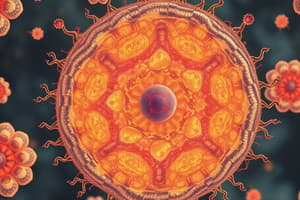Podcast
Questions and Answers
What is the function of the cytoplasm in a cell?
What is the function of the cytoplasm in a cell?
- DNA storage
- Energy production
- Protein synthesis
- Chemical reactions (correct)
Which cell structure houses the genetic instructions of an organism?
Which cell structure houses the genetic instructions of an organism?
- Plasma membrane
- Endoplasmic Reticulum
- Cytoplasm
- Nucleus (correct)
What is the main function of the plasma membrane in a cell?
What is the main function of the plasma membrane in a cell?
- Energy production
- Protein synthesis
- Control movement of materials (correct)
- DNA storage
Which part of the cell is involved in protein synthesis and processing?
Which part of the cell is involved in protein synthesis and processing?
Which type of Endoplasmic Reticulum (ER) is studded with ribosomes?
Which type of Endoplasmic Reticulum (ER) is studded with ribosomes?
What is housed inside the nucleus of a cell?
What is housed inside the nucleus of a cell?
What is the main function of the Golgi Apparatus?
What is the main function of the Golgi Apparatus?
Which organelle is known as the powerhouse of the cell?
Which organelle is known as the powerhouse of the cell?
Which type of cell lacks membrane-bound nuclei?
Which type of cell lacks membrane-bound nuclei?
What is the primary function of ribosomes?
What is the primary function of ribosomes?
Which organelle is exclusively found in plant cells and enables photosynthesis?
Which organelle is exclusively found in plant cells and enables photosynthesis?
Where are Archaeal Cells known to thrive?
Where are Archaeal Cells known to thrive?
Flashcards are hidden until you start studying
Study Notes
Science and Cell Structure
Cells are fundamental units of life, serving as the building blocks of all living organisms from plants and animals to fungi and bacteria. Understanding cell structures is crucial in various fields such as biology, medicine, and agriculture. Here's what you need to know about cells and their different components.
Components of Cells
A typical cell consists of several key parts:
- Cytoplasm: This is the gel-like substance inside the cell where most of the chemical reactions occur. It contains proteins, carbohydrates, lipids, salts, water, and other smaller molecules required by the cell.
- Nucleus: The nucleus houses the DNA molecule, which carries the genetic instructions used to construct and maintain the organism. Inside the nucleus, there are also small bodies called chromosomes, each containing one copy of the entire genome, folded into loops.
- Plasma Membrane: This membrane forms the outer boundary of the cell and acts as a barrier between the cytoplasm and its environment. It controls the movement of materials in and out of the cell.
- Endoplasmic Reticulum (ER): A network of flattened sacs within the cytoplasm involved in protein synthesis and processing, as well as lipid synthesis. There are two distinct types of ER: rough ER, studded with ribosomes, and smooth ER, without them.
- Golgi Apparatus: A complex of membranes and vesicles responsible for modifying, sorting, and packaging newly synthesized proteins and lipids before they are transported throughout the cell or exported outside it.
- Mitochondria: Also known as the powerhouse of the cell, mitochondria produce energy through a process called cellular respiration. They generate most of our body's supply of adenosine triphosphate (ATP), the main source of fuel for the cell.
- Ribosomes: These are tiny particles, some composed of RNA only, occurring singly or in pairs, chiefly located in the cytoplasm. They function primarily in protein synthesis.
- Chloroplasts: These are found exclusively in plant cells and contain chlorophyll, enabling photosynthesis—the production of glucose through sunlight absorption. Plastids can exist in both green and colorless forms; those lacking pigment are often referred to as leukoplasts.
Different Types of Cells
There are three major divisions of cells according to their complexity:
- Prokaryotic Cells: These simple cells lack membrane-bound nuclei and other defined internal compartments. Examples include bacteria and archaea.
- Eukaryotic Cells: Unlike prokaryotes, these more complex cells have a true nucleus and membrane-bound organelles. Most animal, plant, fungal, protozoan, algal, and certain bacterial cells belong to this category.
- Archaeal Cells: Archaea form another group of single-celled microorganisms closely related to bacteria. However, unlike Eubacteria, Archaea tend to live in extreme environments like hot springs and deep sea hydrothermal vents.
Understanding cell structure is essential because every type of biological activity involves cells interacting with each other. For instance, nerve impulses travel along the axon of a neuron and are transmitted across synapses to other nerve cells or muscle fibers. Similarly, digestion begins when food reaches the stomach lining, where acids and enzymes break down large organic molecules into simpler ones that can be absorbed.
Studying That Suits You
Use AI to generate personalized quizzes and flashcards to suit your learning preferences.




